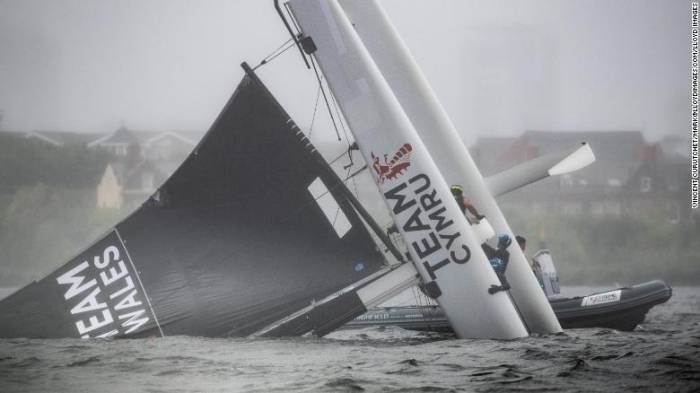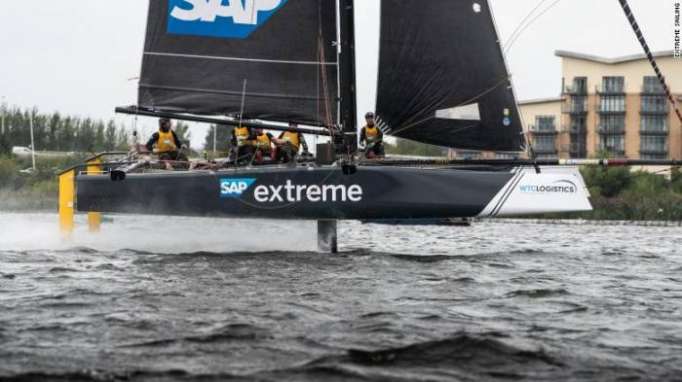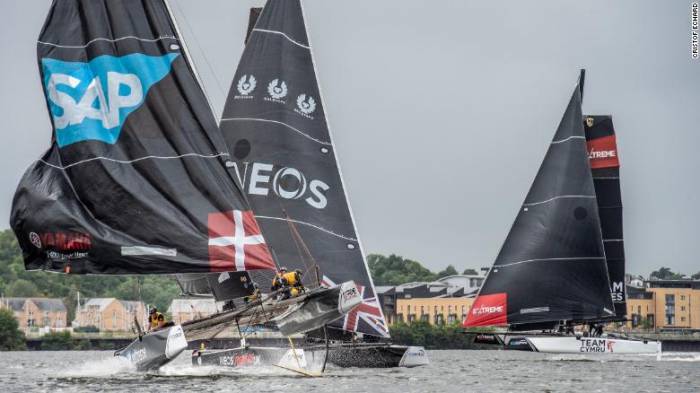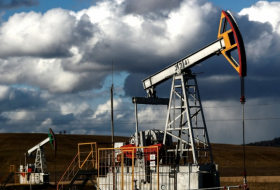Racing towards the first turn as driving rain lashes the Welsh coast line, a huge gust of wind throws the SAP Extreme Sailing boat sideways. It shudders for what seems like an eternity, and then steadies itself.
"THREE, TWO, ONE. GO!' shouts helmsman Adam Minoprio, as the 32-foot boat crashes back down onto the water with a deafening sound before performing the equivalent of a handbrake turn in less time than it takes Usain Bolt to run 100 meters.

Rocketship
As a guest sailor in the Extreme Sailing Series, I am sitting at the front of the catamaran, desperately hanging on to two handles attached to a bit of netting, when dozens of liters of sea water land right in my face.
Before I can shake my head, the 2,000-pound rocketship lifts off again on its foils -- which feels very much like taking off in an airplane -- to race towards the finish line on the other side of the bay at more than 60 kph (37 mph).

The SAP Extreme Sailing team flying across Cardiff Bay.
Minoprio shouts more instructions to his supremely fit four-man crew, who work frantically to control the boat as they winch sails and hydrofoils while trying to keep their balance.
"Well done!" says trim assist/grinder Julius Hallström, a powerfully built Swede, as he slaps me on the back with a big grin as I leave the boat at the end of two practice laps, my heart pounding in my chest.
Stadium racing
I guess they really meant it when they called this the "Extreme Sailing Series" when it first started in 2007.
Growing up in the Netherlands, I used to go sailing as a child in the northern provinces. Most of this involved rather sedate trips on a slow wooden sailing boat on sunny days and on calm waters.

The five-man strong Extreme Sailing crew are directed by the helmsman and have to work closely together as they navigate the boat around a very compact course.
But this is sailing of an entirely different kind: it's high-octane, high-speed stuff with the adrenaline pumping as the boats sometimes come within barely a meter of crashing into each other while negotiating the compact course.
Often called the "Formula One" of the seas, the Extreme Sailing circuit is unique in two ways. Unlike most other sailing races, Extreme Sailing events are designed for spectators, who can watch the world's top sailors go into battle in races taking between 10 and 15 minutes that are held close to the shore in stadium circuits in the Middle East, Europe and the Americas.
Guest sailor
The other unique aspect of the series is that non-sailors like me have the opportunity to join the five-man crew as a guest sailor.
"It's like playing a doubles match with Serena Williams," said SAP Extreme Sailing Team skipper Rasmus Køstner. "You won't see anything in any other sport that is like that."
"We have a great passion for sailing, and often sailing is a sport that is a little bit hard to explain," adds Jes Gram-Hansen, who founded the SAP team with fellow Dane and America's Cup team mate Køstner in 2011 when they invested $400,000 in buying a boat.
"A lot of the interaction with the crew is within a split-second," said Gram-Hansen. "People that go on the boat get a very good understanding of this sport and how challenging it can be."
Ben Ainslie
Over the years, Extreme Sailing has attracted some of the best sailors in the world, ranging from Olympic, world and European champions to America's Cup and Volvo Ocean Race competitors, including Britain's four-time Olympic gold medalist Ben Ainslie.
Over the course of four days in Cardiff Bay, seven teams contest 29 short races, and travel a total distance of 453 nautical miles, according to SAP Analytics, which has been providing the sailors with data and analysis since 2012.
Double capsize
Racing on such short courses at the speed of a car is not without danger.
The day before I joined the team for a practice run, they capsized when a strong gust of wind caught the boat, submerging both hulls.
During the skipper's press conference the next day, there were a lot jokes being cracked about incident.
"It's probably a case of win or swim," quips Oman Air skipper Phil Robertson. "Mast up in the air is a good day."
It's enough to make me a tad nervous, particularly with gusts of between 22 and 26 knots forecast for our practice run, after it was deemed too dangerous for me to join the actual race.
"Just hold on tight, don't try and climb higher, but make sure you exit sideways," said Hallström, as I walk onto the boat, dressed in waterproof trousers and jacket and a helmet. "But don't worry, we will take care of you."
After I exit the GC32 to enter its follow boat with SAP team principal and coach Gram-Hansen on board, the Red Bull Sailing Team boat almost capsizes as it gets caught by a gust of wind.
On the third day of racing in Cardiff, once again with strong winds and torrential rain, the Oman Air boat and Team Wales both capsized within moments of each other. Although no one got seriously hurt, one Oman Air crew member was taken back to dry land after sustaining an injury.
"Most people think sailing is a very romantic sport," said Gram-Hansen. "That you are out there, cruising along, chilling out. And this is exactly the opposite. This is so intense, there is so much power in the boat, they go really fast."
The next event will be held in San Diego between October 18 and 21, followed by the season finale in Los Cabos, Mexico, from November 29 to December 2.
CNN
More about: sport















































